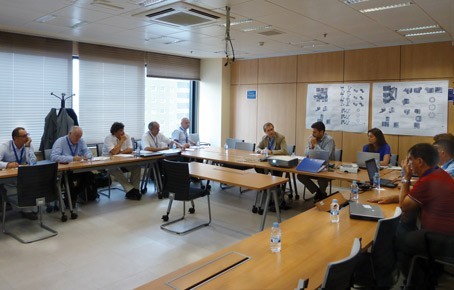Kick-off meeting for two major Neutral Beam Test Facility components


A kick-off meeting between F4E and the Italian company Coelme was held during the summer to discuss the design, manufacturing and installation of the SPIDER High-Voltage deck (HVD) and Transmission Line (TL) at the Neutral Beam Test Facility (NBTF) at the Consorzio RFX site in Padova, Italy. This kick-off meeting follows a flurry of contracts for the NBTF that were signed late last year and clearly shows how the set of the main European industrial contracts for the construction of Spider is rapidly being completed.
The NBTF will house two independent test beds, namely SPIDER (Source for Production of Ion of Deuterium Extracted from Radio frequency plasma), where the first full-scale ITER ion source will be tested and developed with an acceleration voltage up to 100 kV; and MITICA (Megavolt ITER Injector and Concept Advancement) which will be the first 1:1 full ITER injector aiming at operating up to the full acceleration voltage of 1 MV and at full power (16.5 MW). F4E will supply the ITER machine with two neutral beam (NB) injectors (i.e. two similar injectors such as in MITICA). These injectors are essential for heating and reaching the high temperature necessary for fusion reactions to occur in the plasma.
The HVD and the TL are two vital components for the SPIDER experiment. The HVD consists of a mechanical structure which will hold the set of power supply equipment weighing around 40 t. Measuring approximately 13 × 11 m, the HVD will be installed in a pit around 1 m below ground-floor level, and will be mounted on supporting insulators so that it can withstand the high 100 kV voltage of the power supplies. The HVD will be covered by a metallic screen in order to reduce electromagnetic interference, which could have negative effects on the power supply.
The high-voltage Transmission Line will connect the power supplies installed inside the HVD to the SPIDER ion source and beam acceleration. Measuring around 30 m in length, the Transmission Line uses unique double-screening sandwich panels which give extra protection against electromagnetic interference.
The kick-off meeting provided the opportunity to explain how this contract fits within the overall context of the ITER project, the key actors and their respective roles, and to set up the information and communication flows. The meeting also marks the start of the work on the detailed design of both the HVD and the TL. Following the completion of the design, which is expected by the end of 2013, manufacturing of the two components will start. It is envisaged that the HVD will be ready for installation in mid-2014, and the TL will follow 6 months later. Final acceptance will take place after site testing, which is scheduled for the end of 2014 and mid-2015.